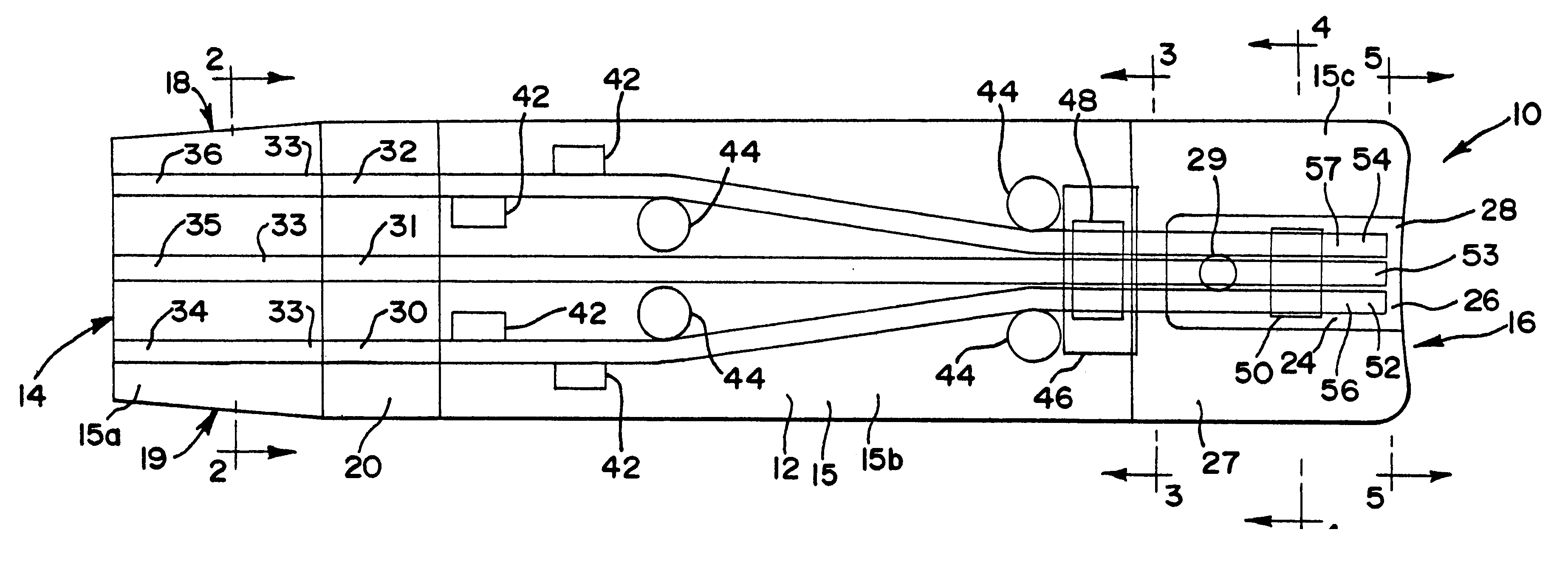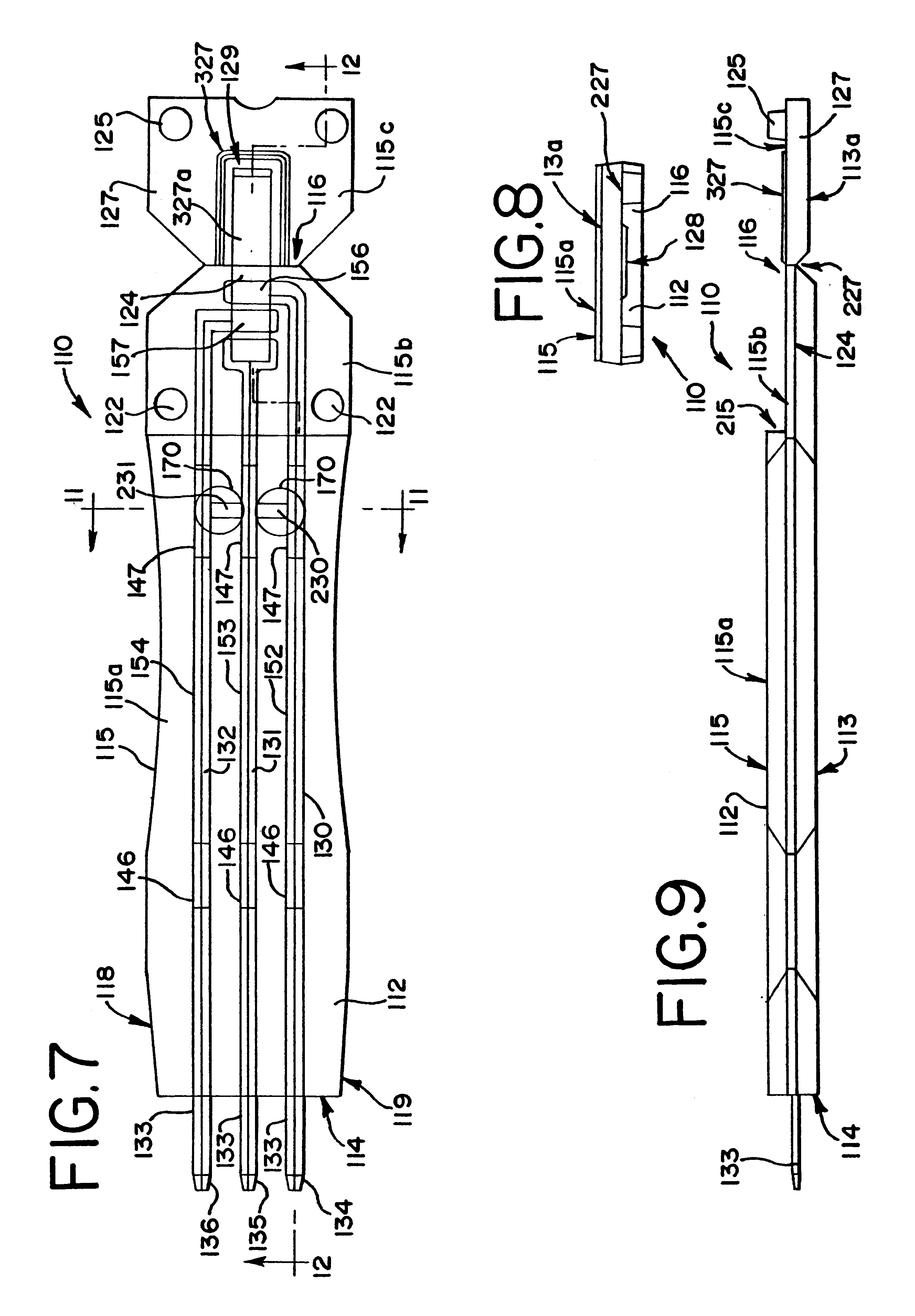Method of making sensor
- Summary
- Abstract
- Description
- Claims
- Application Information
AI Technical Summary
Benefits of technology
Problems solved by technology
Method used
Image
Examples
first embodiment
The First Embodiment
Referring to FIGS. 1-6, an electrochemical sensor in accordance with the present invention, first embodiment, is depicted. FIG. 1 shows the sensor 10 as though it were made out of clear plastic, permitting one to look inside it. As discussed herein, the internal components and hidden external components would not normally be visible looking down on the sensor 10. This rendition would be similar to a view taken along plane x—x in FIG. 2.
The sensor or test strip of the first embodiment 10 includes an injection molded plastic body 12, opaque or preferably translucent, having a meter attachment end or plug end 14 and a fluid sample receiving end 16. The body has a bottom surface 13, a top surface 15 and a tapered portion 20 connecting a first top surface 15a to a second top surface 15b, the first top surface being lower than the second top surface, and a third top surface 15c, also lower than the second top surface. The body 12 contains three spaced apart electrodes ...
second embodiment
The Second Embodiment
Referring to FIGS. 7-12, an electrochemical sensor in accordance with the present invention, second embodiment, is depicted. In these figures, components similar to those in the first embodiment (10) will be identified with the same reference numbers, but in the 100 series. Specifically, FIG. 7 shows the sensor 110 as though it were made out of clear plastic, permitting one to look inside it. As noted previously, the internal components and hidden external components would not normally be visible looking down on the sensor 110. The sensor of the second embodiment 110 includes a molded plastic body 112 having a meter attachment end or plug end 114 and a fluid sample receiving end 116. The body has a bottom surface 113 and a top surface 115. An end cap 127 is integral to the body 112 and molded with the body. A hinge 227 permits the pivoting of the end cap onto the main body as will be explained. Specifically, the top surface 115 of the sensor 110 has three top su...
third embodiment
The Third Embodiment
Shown in FIGS. 13-20 is a third embodiment of an electrochemical sensor in accordance with the present invention. These figures use the same reference numbers, but in the 300 series, to identify components that are similar to those in the previous embodiments. FIGS. 13 and 17, respectively, depict the sensor 310,310′ in its entirety, including its internal components not normally visible when looking down on the sensor 310,310′.
In the third embodiment sensor 310, 310′ is used in conjunction with a meter capable of measuring an electrochemical property of the fluid sample after the fluid sample is drawn into the reaction zone 324,324′. The sensor 310,310′ includes a molded plastic body 312,312′ having a meter attachment end or plug end 314,314′ and a fluid sample receiving end 316,316′. The plug end 314,314′ is insertable or connectable to a meter, as with the two prior embodiments. The body also has a bottom surface 313,313′ and a top surface 315,315′. The body 3...
PUM
| Property | Measurement | Unit |
|---|---|---|
| Electrical conductivity | aaaaa | aaaaa |
| Concentration | aaaaa | aaaaa |
| Plasticity | aaaaa | aaaaa |
Abstract
Description
Claims
Application Information
 Login to View More
Login to View More - R&D
- Intellectual Property
- Life Sciences
- Materials
- Tech Scout
- Unparalleled Data Quality
- Higher Quality Content
- 60% Fewer Hallucinations
Browse by: Latest US Patents, China's latest patents, Technical Efficacy Thesaurus, Application Domain, Technology Topic, Popular Technical Reports.
© 2025 PatSnap. All rights reserved.Legal|Privacy policy|Modern Slavery Act Transparency Statement|Sitemap|About US| Contact US: help@patsnap.com



